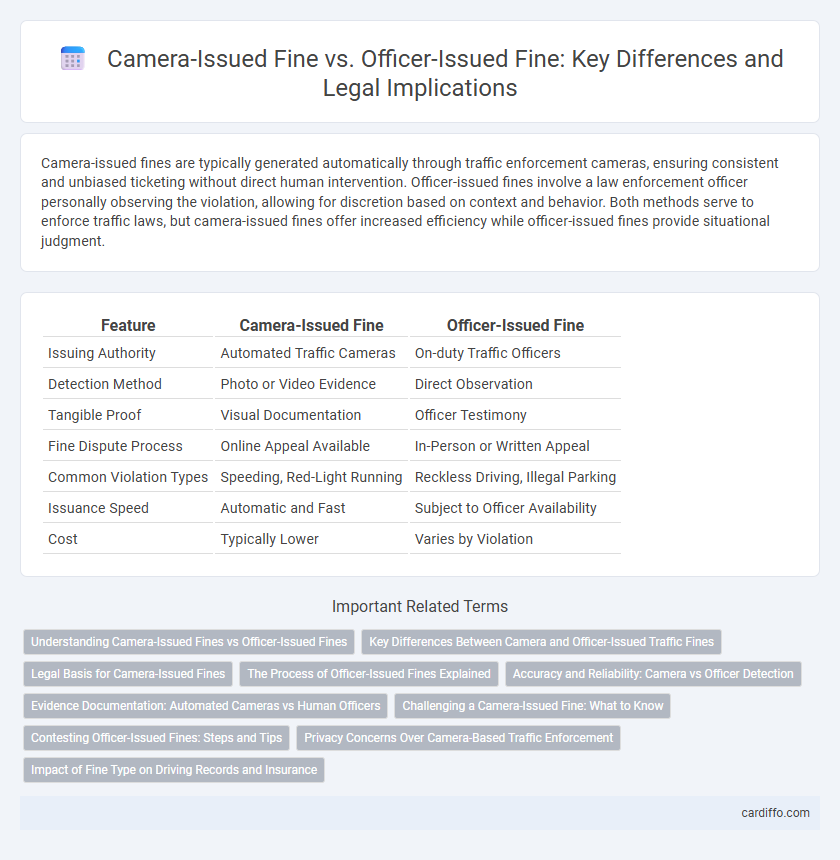Camera-issued fines are typically generated automatically through traffic enforcement cameras, ensuring consistent and unbiased ticketing without direct human intervention. Officer-issued fines involve a law enforcement officer personally observing the violation, allowing for discretion based on context and behavior. Both methods serve to enforce traffic laws, but camera-issued fines offer increased efficiency while officer-issued fines provide situational judgment.
Table of Comparison
| Feature | Camera-Issued Fine | Officer-Issued Fine |
|---|---|---|
| Issuing Authority | Automated Traffic Cameras | On-duty Traffic Officers |
| Detection Method | Photo or Video Evidence | Direct Observation |
| Tangible Proof | Visual Documentation | Officer Testimony |
| Fine Dispute Process | Online Appeal Available | In-Person or Written Appeal |
| Common Violation Types | Speeding, Red-Light Running | Reckless Driving, Illegal Parking |
| Issuance Speed | Automatic and Fast | Subject to Officer Availability |
| Cost | Typically Lower | Varies by Violation |
Understanding Camera-Issued Fines vs Officer-Issued Fines
Camera-issued fines rely on automated technology to capture traffic violations, providing objective evidence such as photos or videos, which reduces disputes and speeds up the citation process. Officer-issued fines depend on direct observation and judgment during traffic stops, allowing for discretion based on circumstances but may lead to subjective enforcement. Understanding these differences helps drivers recognize how evidence is gathered and the potential impact on contesting a fine.
Key Differences Between Camera and Officer-Issued Traffic Fines
Camera-issued traffic fines are typically automated and rely on photographic evidence to capture violations such as speeding or running red lights, ensuring consistent enforcement without human bias. Officer-issued fines involve an on-site traffic officer who assesses the situation, allowing for discretion and immediate interaction with the driver. Camera fines often streamline processing through mail or online systems, whereas officer-issued fines may require in-person hearings or court appearances.
Legal Basis for Camera-Issued Fines
Camera-issued fines derive their legal basis from traffic enforcement laws that authorize automated devices to detect and record violations such as speeding and red-light running. These fines rely on photographic or video evidence captured by calibrated equipment, ensuring objective and accurate violation proof accepted in court. Legislation typically outlines the standards for camera placement, operation, data handling, and notification procedures to uphold due process and protect driver rights.
The Process of Officer-Issued Fines Explained
Officer-issued fines involve a law enforcement officer directly observing a traffic violation, documenting the infraction on-site, and issuing a citation to the offender. The process typically includes recording essential details such as the driver's license, vehicle registration, and specific violation to create an official report. Unlike camera-issued fines, officer-issued fines may allow for immediate interaction and clarification with the violator, often leading to a more transparent enforcement procedure.
Accuracy and Reliability: Camera vs Officer Detection
Camera-issued fines offer enhanced accuracy and reliability by capturing precise evidence such as time-stamped images and videos, reducing human error and bias in enforcement. Officer-issued fines depend on subjective judgment, which can lead to inconsistencies and disputes over accuracy. Automated camera systems provide consistent detection of traffic violations, ensuring a higher standard of proof compared to officer observations alone.
Evidence Documentation: Automated Cameras vs Human Officers
Automated cameras provide consistent and objective evidence documentation through high-resolution images and precise timestamps, reducing the risk of human error or bias. Human officers rely on observational skills and written reports, which may introduce subjectivity or inconsistencies in evidence recording. The reliability and clarity of camera-issued fines often lead to stronger legal standing compared to officer-issued citations.
Challenging a Camera-Issued Fine: What to Know
Challenging a camera-issued fine requires understanding the specific regulations governing automated traffic enforcement in your jurisdiction, as these fines are often supported by photographic or video evidence. Key defenses include questioning the accuracy of the captured data, verifying the correct vehicle registration details, or proving compliance with traffic laws at the time of the incident. Unlike officer-issued fines, camera-issued infractions typically rely on strict adherence to procedural guidelines, making it crucial to review evidence and procedural compliance thoroughly before contesting the fine.
Contesting Officer-Issued Fines: Steps and Tips
Contesting officer-issued fines requires gathering all relevant evidence, such as photos, witness statements, and official documents, to support your case effectively. Carefully review the ticket details for errors or inconsistencies that can be challenged during the appeal process. Submit a formal written contestation within the specified deadline, clearly outlining your argument and providing any proof to enhance your chances of a favorable outcome.
Privacy Concerns Over Camera-Based Traffic Enforcement
Camera-issued fines raise significant privacy concerns due to continuous surveillance and the potential misuse of personal data collected without explicit consent. Unlike officer-issued fines, which involve direct human interaction and immediate identification, camera-based enforcement systems store vast amounts of vehicle and driver information that may be vulnerable to data breaches and unauthorized access. Public debate emphasizes the need for stringent data protection policies and transparency in the deployment of automated traffic monitoring technologies to safeguard individual privacy rights.
Impact of Fine Type on Driving Records and Insurance
Camera-issued fines often result in penalty points being added directly to the driver's record, similar to officer-issued fines, but the immediacy and frequency can lead to a faster accumulation of points. Insurance companies typically view both types of fines as indicators of risky driving, causing increased premiums; however, multiple camera fines within a short period may escalate rates more sharply due to perceived habitual infractions. The electronic enforcement of camera fines creates a more consistent capture of violations, potentially impacting driving history and insurance evaluations more continuously than sporadic officer-issued fines.
Camera-issued fine vs officer-issued fine Infographic

 cardiffo.com
cardiffo.com